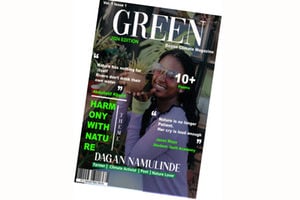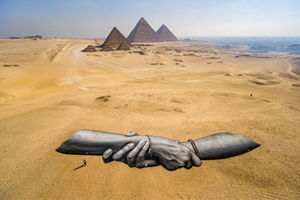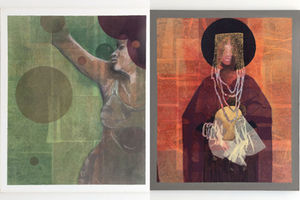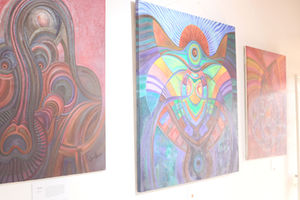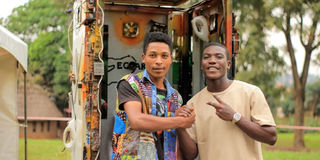
Christopher Kwizera (left) on his telephone booth installation with a reveller. PHOTO/Global Rights Alert
The world is fast turning into a concrete jungle. With people putting up a structure in every corner of an urban centre, it is safe to say the call for more green has never been timelier.
Last week, there was a call for a green Uganda, but not in ways people are used to. A group of artists came together to showcase the dangers of polluting the environment using plastic, fossils and technological waste.
Artists currently under artist Bruno Ruganzu’s Eco Art Uganda studio, collaborated on an exhibition that was put together at Ndere Centre on Ntinda-Kisasi Road.
With different plastic cutaways, radio and mobile telephone waste, and plastic, the artists told sad stories about the environment and the people who have not loved it as much as they would.
Titled Artists for Climate Justice, the exhibition brought together disciplines such as symbolic installations, oil painting, and sculpture.
Unlike other exhibitions where the medium for all painters is oil on canvas, this exhibition introduced plastic on plywood. Linda Suzan Aliba had one of the catchy works on display.

Some of the art pieces that showcased the dangers of polluting environment using plastic, fossils and technological waste during the Artists for Climate Justice exhibition at Ndere Centre . PHOTO/Global Rights Alert
From afar, it was clearly oil on canvas, but on closer inspection, they were merely pieces of cut plastic in red, blue, green, yellow and red. With the pieces, she cuts mainly from bottle tops and asystematically arranges them on plywood to create images the same way one would with oil and brush or pyrography.
Aliba says everyone interacts with plastic in their life, thus some of her works, Innocence and Tomorrow We Wish For, are both centred on children and how plastic waste affects them.
Innocence, for instance, features a smiling child whose background is a factory emitting fumes in the air. The picture takes a lighter tone for the child’s face, although as it progresses, the shades become darker.
“What kind of world do we want for future generations? A thriving or decaying one?” she wonders.
Wilberforce Sserunjogi had revellers marveling at his Omunaku installation. The installation in shape of fuel lamp is inspired by local lamps known as tadooba.
The lamps get their Luganda name from a statement omunaku tadooba, loosely translated as the poor man’s solution to challenges of life. On the contrary, the fumes emitted by the lamp expose people to lung problems.

Linda Suzan Aliba displays her plastic painting.
PHOTO/Global Rights Alert
The installation, which is also functional with seats inside, gives attendees a chance to experience a small room with a lit tadooba and in minutes, most of the people who were in there, were uncomfortable.
“This is what some people go through everyday in rural areas, there are children reading books every night using tadooba. More awareness is needed and clean energy needs to be made available for such people,” he says.
Most of the works displayed are strong with messages, although there is still an opportunity for the audience to have their own interpretations. All the installations exploit waste such as broken padlocks, wheels, helmets, telephones and computer boards.
Christopher Kwizera, for instance, mainly uses e-waste to create his phonebooth. It is also functional, but also manages to start a conversation on the role of technology plays in destroying the environment.
Like Aliba, Joachim Ogwado repurposes plastic, using it to create awareness about the hazard plastic presents towards water bodies. The installation mainly made out of mineral water bottles explores biodiversity protection and livelihood. The artist says, that every bottle in the installation solved a human problem though became a problem for the earth.
Jackson Kirisa and Alex Kwizera were the two oil painters with works available. Kirisa draws inspiration from human exploitation of natural resources.
Organised by Global Rights Alert, the exhibition ignited a conversation that many of those in attendance managed to have in form of a round table. It was interesting listening to the different perspectives people had about the work on display.
